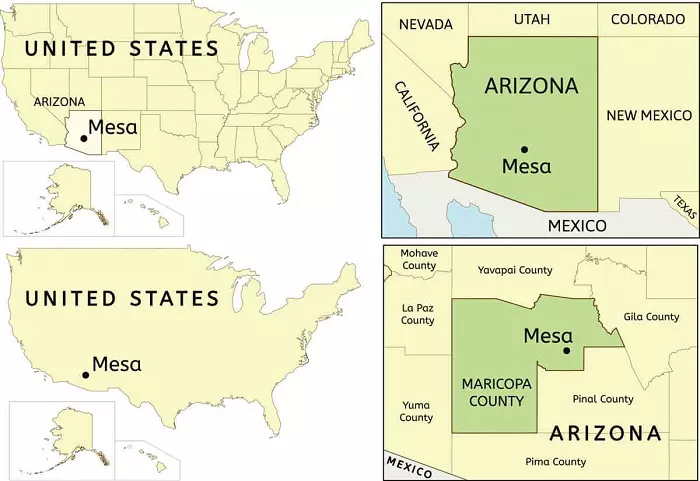Mesa, Arizona is one of the largest and most vibrant cities in the American Southwest. Many people wonder, “Where is Mesa, Arizona on a map?” This comprehensive guide explores Mesa’s geographical location, cultural significance, economic drivers, and ecological features. Whether you’re considering relocating, planning a visit, or simply curious about this desert metropolis, this article provides all the key details in an easy-to-understand format.
Geographical Location of Mesa, Arizona
Exact Location and Coordinates
Mesa is located in Maricopa County in central Arizona, about 20 miles east of downtown Phoenix. Key geographical details include:
- Coordinates: 33.4152° N latitude, 111.8315° W longitude
- Elevation: 1,243 feet (379 meters) above sea level
- Area: 138 square miles (357 square km) – larger than Miami or Minneapolis
- Time Zone: Mountain Standard Time (no Daylight Savings Time observed)
How to Locate Mesa on a Map
Finding Mesa on an Arizona map is simple:
- Locate Phoenix in the south-central part of the state
- Look directly east of Phoenix along the Salt River
- Identify the large urban area bordering Tempe to the west and Apache Junction to the east
Mesa sits in the East Valley region of the Phoenix metropolitan area, connected by:
- US 60 (Superstition Freeway)
- Loop 101 and Loop 202 freeways
- Valley Metro Light Rail (connecting to Phoenix and Tempe)
Surrounding Cities and Landmarks
Key neighboring areas include:
- Phoenix (west)
- Tempe (northwest)
- Chandler (south)
- Gilbert (southeast)
- Apache Junction (east)
Notable nearby landmarks:
- Salt River (forms northern border)
- Superstition Mountains (visible to the east)
- Mesa Gateway Airport (southeast Mesa)
- Saguaro Lake (northeast)
Cultural Significance of Mesa
Historical Background
Mesa’s cultural roots trace back to:
- Hohokam people (ancient Native American civilization that built irrigation canals)
- Mormon settlers (founded the city in 1878)
- Post-WWII growth (transformed from agricultural town to major suburb)
Modern Cultural Landscape
Today, Mesa offers diverse cultural attractions:
- Mesa Arts Center (largest arts campus in Arizona)
- Arizona Museum of Natural History (dinosaur exhibits and Southwest history)
- Mesa Temple (historic Mormon landmark)
- Annual festivals (including the Arizona Celebration of Freedom)
Demographics and Community
Key population facts (2023 estimates):
- Population: 520,000+ (3rd largest city in Arizona)
- Median age: 35.6 years
- Ethnic diversity: 60% White, 30% Hispanic, 5% Native American
- Notable feature: Large retirement community (about 15% of population over 65)
Economy of Mesa
Major Industries and Employers
Mesa’s economy features diverse sectors:
Aerospace & Defense:
- Boeing (helicopter manufacturing)
- Falcon Field Airport (aviation hub)
Technology:
- Apple (data center operations)
- Nammo Talley (defense technology)
Healthcare:
- Banner Health System
- Mayo Clinic Hospital
Education:
- Arizona State University Polytechnic campus
- Mesa Community College
Economic Strengths
- Lower cost of living than Phoenix or Scottsdale
- Growing job market (3.5% employment growth in 2022)
- Tourism revenue ($1.2 billion annually from visitors)
Economic Challenges
- Water scarcity concerns for future growth
- Urban sprawl management
- Dependence on Phoenix metro economy
Ecology and Environment
Desert Climate Characteristics
Mesa has a hot desert climate (Köppen BWh):
- Summer highs: 105-115°F (June-August)
- Winter lows: Rarely below 40°F
- Rainfall: Only 9 inches annually
- Special feature: “Monsoon season” (July-September with dramatic thunderstorms)
Native Flora and Fauna
Common desert species include:
- Plants: Saguaro cactus, palo verde trees, creosote bushes
- Animals: Coyotes, javelinas, roadrunners, Gila monsters
- Birdlife: Hawks, quail, and migratory species
Environmental Challenges
Key ecological concerns:
- Urban heat island effect (temperatures 5-10°F hotter than surrounding desert)
- Water conservation (reliance on Colorado River and groundwater)
- Habitat loss from urban expansion
- Air quality issues (ozone pollution in summer)
Transportation and Infrastructure
Road Networks
Major transportation routes:
- US 60 (east-west corridor)
- Loop 101/202 (beltway system)
- State Route 87 (connects to Payson)
Public Transit Options
- Valley Metro Light Rail (connects to Phoenix/Tempe)
- Bus system (local and express routes)
- Bike share programs (expanding network of bike lanes)
Air Travel Access
Two major airports serve Mesa:
- Phoenix-Mesa Gateway Airport (AZA):
-
- Focus on budget airlines (Allegiant, Sun Country)
- 2 million passengers annually
- Sky Harbor International (30 minutes west in Phoenix)
Quality of Life in Mesa
Housing Market Overview
2023 housing statistics:
- Median home price: $425,000
- Rent average: $1,450/month
- Notable feature: Many 55+ retirement communities
Education System
Top-rated schools and institutions:
- Public schools: Mesa Public Schools district
- Higher education:
- Arizona State University Polytechnic
- Mesa Community College
- Benedictine University
Recreation and Leisure
Popular attractions:
- Usery Mountain Regional Park (hiking trails)
- Mesa Grande Cultural Park (ancient ruins)
- Sloan Park (Chicago Cubs spring training)
- Golf courses (over 30 in the area)
Conclusion
Mesa, Arizona is a dynamic desert city with a unique blend of urban amenities and Southwestern character. Located just east of Phoenix in the Salt River Valley, it offers affordable living, strong job opportunities, and year-round sunshine. While facing typical desert city challenges like water management and urban heat, Mesa continues to grow as a preferred destination for families, retirees, and businesses.

